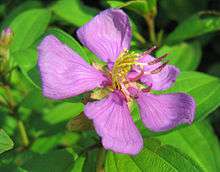Melastoma malabathricum
| Melastoma malabathricum | |
|---|---|
 | |
| Scientific classification | |
| Kingdom: | Plantae |
| (unranked): | Angiosperms |
| (unranked): | Eudicots |
| (unranked): | Rosids |
| Order: | Myrtales |
| Family: | Melastomataceae |
| Genus: | Melastoma |
| Species: | M. malabathricum |
| Binomial name | |
| Melastoma malabathricum L. | |
| Synonyms | |
| |
Melastoma malabathricum, known also as Malabar melastome, Indian rhododendron and Singapore rhododendron (Malay: senduduk; Thai: โคลงเคลงขี้นก, khlong khleng khi nok)[2] is a flowering plant in the family Melastomataceae.
It is present in Indonesia, Japan, Burma, Cambodia, Laos, India, Malaysia, Nepal, Philippines, Thailand and Vietnam. It is usually found between 100 and 2,800 m on grasslands and sparse forests.[3] It has been declared a noxious weed in the United States.[4]
This plant has been used as a medicinal plant in certain parts of the world.[5]
Melastoma malabathricum is a known hyperaccumulator of aluminium, and as such can be used for phytoremediation.[6]
Taxonomy
The taxonomy of the genus Melastoma requires a complete revision.[7] Early genetics studies were published from 2001,[8] through to recently,[9] but a revision based on them has yet to be. In 2001 Karsten Meyer proposed a revision in which the species Melastoma affine and other species were subsumed within this species M. malabathricum.[10]
In Australia, currently most authorities do not accept this; instead the naturally occurring populations in Western Australia, Northern Territory, Queensland and north eastern New South Wales remain recognised as M. affine,[11][12] except by authorities in Queensland.[13][14] Australian populations which occur as weeds, having different flowers, for example in Warraroon Reserve, Lane Cove, Sydney, further south than the natural distribution of M. affine, are introduced plants of this M. malabathricum L. species.[15]
References
- ↑ http://www.theplantlist.org/tpl/record/tro-20302081
- ↑ Malabar Melastome
- ↑ Melastoma malabathricum - Flora of China
- ↑ Germplasm Resources Information Network (GRIN)
- ↑ Melastoma malabathricum (L.) Smith Ethnomedicinal Uses, Chemical Constituents, and Pharmacological Properties
- ↑ Distribution and chemical speciation of aluminum in the Al accumulator plant, Melastoma malabathricum L. By Toshihiro Watanabe, Mitsuru Osaki, Teruhiko Yoshihara and Toshiaki Tadano. In journal “Plant and Soil”. Ed. Springer Netherlands, Volume 201, Number 2 / April, 1998. pp. 165-173. ISSN 0032-079X (Print) 1573-5036 (Online). DOI 10.1023/A:1004341415878.
- ↑ Whiffin, Trevor (1990). "Melastoma". Flora of Australia: Volume 18: Podostemaceae to Combretaceae (online version). Flora of Australia series. CSIRO Publishing / Australian Biological Resources Study. pp. 247–248. ISBN 978-0-644-10472-2. Retrieved 18 June 2013.
- ↑ Clausing, G.; Renner, Susanne S. (2001). "Molecular phylogenetics of Melastomataceae and Memecylaceae: implications for character evolution". American Journal of Botany. 88 (3): 486–498. doi:10.2307/2657114. Retrieved 19 June 2013. – see also the erratum.
- ↑ Michelangeli, Fabián A.; Guimaraes, Paulo J. F.; Penneys, Darin S.; et al. (2013). "Phylogenetic relationships and distribution of New World Melastomeae (Melastomataceae)". Botanical Journal of the Linnean Society. 171 (1): 38–60. doi:10.1111/j.1095-8339.2012.01295.x. ISSN 1095-8339. Retrieved 18 June 2013.
- ↑ Meyer, Karsten (2001). "Revision of the Southeast Asian genus Melastoma (Melastomataceae)". Blumea. 46 (2): 351–398.
- ↑ Australian Plant Name Index (APNI), Integrated Botanical Information System (IBIS) database (listing by % wildcard matching of all taxa relevant to Australia). Centre for Plant Biodiversity Research, Australian Government http://www.anbg.gov.au/cgi-bin/apni?00TAXON_NAME=Melastoma%25. Retrieved 18 June 2013. Missing or empty
|title=(help);|contribution=ignored (help) - ↑ Wilson, Peter G. (July 2001). "Melastoma affine D.Don – New South Wales Flora Online". PlantNET - The Plant Information Network System. 2.0. Sydney, Australia: The Royal Botanic Gardens and Domain Trust. Retrieved 18 June 2013.
- ↑ Hyland, B. P. M.; Whiffin, T.; Zich, F. A.; et al. (Dec 2010). "Factsheet – Melastoma malabathricum subsp. malabathricum". Australian Tropical Rainforest Plants. Edition 6.1, online version [RFK 6.1]. Cairns, Australia: Commonwealth Scientific and Industrial Research Organisation (CSIRO), through its Division of Plant Industry; the Centre for Australian National Biodiversity Research; the Australian Tropical Herbarium, James Cook University. Retrieved 18 June 2013.
- ↑ Bostock, P.D.; Holland, A.E., eds. (2010). Census of the Queensland Flora 2010. Brisbane: Queensland Herbarium, Department of Environment and Resource Management. p. 101. Retrieved 18 June 2013.
- ↑ Hosking, J. R.; Conn, B. J.; Lepschi, B. J.; Barker, C. H. (2011). "Plant species first recognised as naturalised or naturalising for New South Wales in 2004 and 2005" (PDF). Cunninghamia. 12 (1): 85–114. Retrieved 18 June 2013.
External links
| Wikimedia Commons has media related to Melastoma malabathricum. |